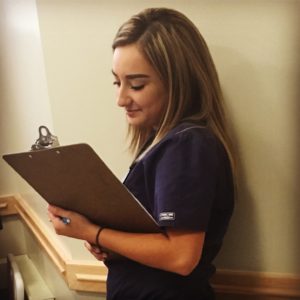Taking a Breath: Level 1 Nursing Students take on their First Simulation Scenario

Chronic Obstructive Pulmonary Disease (COPD) is a serious disease that affects the airway and makes it difficult to breathe. Unfortunately, according to the Centers for Disease Control and Prevention, “Almost 15.7 million Americans (6.4%) reported that they have been diagnosed with COPD.”
Since the prevalence of COPD is high, the very first scenario in our simulated hospital room that our Level 1 students worked through was a patient with COPD. We began the scenario by allowing the nursing students to self-select their roles: charge nurse, nursing team, patient voice, family member, and doctor.
The role of the charge nurse required the nurse to engage in a quick assessment of the situation in order to provide leadership to the nursing team. This was a great learning moment about communication, the importance of verbalizing directions, and assessment strategies. Specifically, the charge nurse needed to remember to provide clear instructions and the nursing team needed to remember to share their assessment results back to the charge nurse.
The participants who were a part of the nursing team worked together to utilize their nursing skills by taking quick and accurate assessments, following the doctor’s orders, and engaging in therapeutic communication.
The role of the patient voice was to respond appropriately to the questions being asked by the nurses. One of our nursing students who played the role of “patient voice” did a fantastic job wheezing and coughing. This helped the nursing team critically think about their assessment strategy because it was going to be a lot harder to ask questions to a patient who may be coughing too hard to actually speak.

The role of the family member was a very fun role. The person acting as the family member either chose to be helpful or a distraction. For this session, some family members calmly helped the nursing team by answering questions that the patient could not answer. However, other family members chose to show dramatic concern about their loved one and, thus, made it very hard for the nurses to complete their assessments.
The role of the doctor was to respond to the charge nurse’s assessment results with orders. These orders were a predetermined part of the scenario. However, how the doctor conveyed the information depended on how the charge nurse reported the assessment data. This was another great learning moment about the importance of collecting and communicating accurate assessment data.
Overall, the current Level 1 nursing students did a great job working their way through their first scenario. It was fun and provided numerous learning points that can now be applied to the healthcare facility setting. Additionally, as the quarter progresses, the nurses will have an opportunity to experience each of the roles in the simulated scenarios. Many students have shared that they appreciated being able to be a part of all of the different roles because it helps them take on a different perspective that they can learn from.

